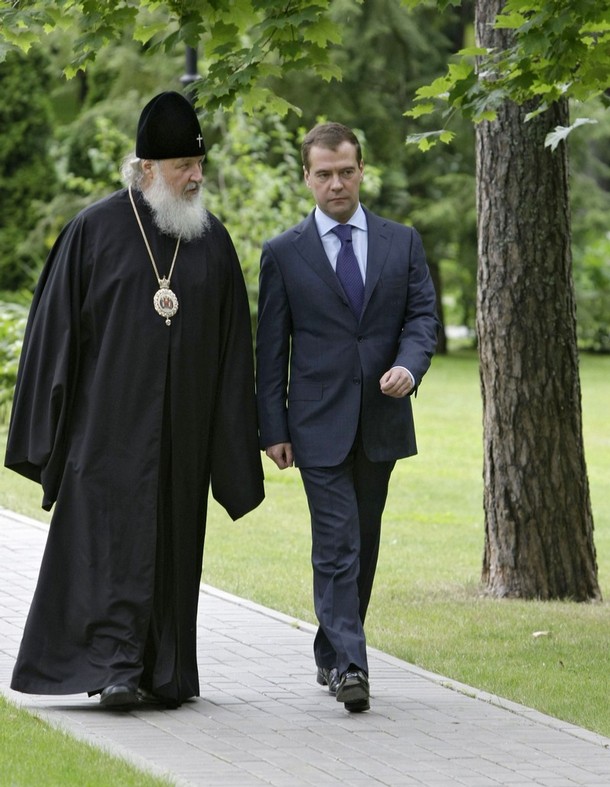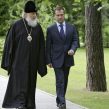
Medvedev “Sanctifies” the Russian Army
Publication: Eurasia Daily Monitor Volume: 6 Issue: 154
By:

On August 3, the Head of the Russian Orthodox Church Patriarch Kirill during his visit to Sevastopol stressed the importance of the work of orthodox clergymen in the Russian army. Kirill stated that the modern soldier must be "strong in spirit" and emphasized the importance of spiritual support for servicemen, noting that, "for warriors to be capable of that [sacrificing their lives], we must support them with our prayers, while clergymen should be working with the armed forces," he explained (Interfax, August 3).
On July 21 Russian President Dmitry Medvedev pledged to support the study of religion in schools and hire chaplains from the major Russian religions to serve in the armed forces (Moscow Times, July 22). Nonetheless, the announcement of this initiative within the military surprised many observers in the country, and its significance was underestimated even within the Russian military press. Medvedev explained that by the end of the year chaplains will be appointed to military units based outside the country, and throughout the armed forces by 2010. "If servicemen who belong to a particular religion make up over ten percent of the entire personnel of a brigade, a division, or higher educational establishment, a priest may be attached to them. I also think that priests attached to military units must remain civilians," he affirmed (ITAR-TASS, July 22).
Defense Minister Anatoliy Serdyukov confirmed that chaplains will be officially introduced in the armed forces in three stages. In the first stage, lasting until the end of 2009, military chaplains will be assigned to forces based abroad. Serdyukov specified the 102nd Russian military base in Armenia, the 201st base in Tajikistan, as well as forces and brigades in Abkhazia, South Ossetia, Kyrgyzstan and Sevastopol. The second stage will involve the introduction of "additional civilian personnel [chaplains] in the main brigades and military subunits and at bases inside Russia." The final stage will form the relevant directorate in the central administration of the military, as well as within the military districts and fleets. The process will be completed by 2010, with an estimated 200-250 chaplains serving within the armed forces on an average wage not "lower than that of a deputy bridge commander in charge of educational work," Serdyukov explained (Interfax, July 21).
As part of the ongoing controversial military reform program, the importance of introducing an official chaplaincy was widely overlooked. Given their absence since the Bolshevik revolution in 1917, many might have been pre-disposed to dismiss this reform as a religious sideshow. Instituting civilian chaplains might provide soldiers with counseling on social problems, ethical and moral standards, as well as religious issues.
One clear indication that the reform agenda might experiment in this manner emerged during the "Center 2008" military exercises in Orenburg in the Volga-Ural Military District in the aftermath of the Russia-Georgia war in August 2008. These exercises were partly aimed at enhancing interoperability between Russian and Kazakhstani forces. The 74-day training event was one of the largest exercises in more than twenty years (ITAR-TASS, September 26, 2008; Interfax, October 16, 2008). However, this exercise also witnessed the participation of representatives from the four main religions in the country. Orthodox priests, mullahs, rabbis, and lamas featured in Center 2008, which marked a new experience for military commanders and the forces taking part. The Commander-in Chief of the Ground Forces Army-General Vladimir Boldyrev said that these "chaplains" were tasked with caring for the "spiritual wellbeing" of the soldiers.
Another factor that probably contributed to the widespread underestimation of this plan to introduce a chaplaincy within the Russian armed forces stems from the previous failed attempts to pursue such schemes. In March 2006, the then Patriarch Alexy II gave his blessing with the approval of the General Staff, to permanently re-introduce the chaplaincy among the troops. Later that year the main military prosecutor’s office drafted legislation to that effect, but it rapidly encountered insurmountable barriers. Fierce opposition erupted from the representatives of other faiths, fearing that the Russian Orthodox Church would dominate the new structure. They justified their objections on the basis that Russia was not only multi-ethnic but it also contained multiple religions, and advanced the claim that "almost half" its military personnel were Muslim. However, official statistics at that stage suggested that in the Russian army only 8 percent were Muslims, and 9 percent were Jews, Buddhists and adherents of other religions, while the vast majority of believers (83 percent) were orthodox (ITAR-TASS, March 17, 2006).
In May 2008 the Deputy Defense Minister Army-General Nikolai Pankov said there was no need to rush the introduction of chaplains into the Russian armed forces. "We have studied the experience of foreign armies, where there are military clergy, and believe that there is no off-hand solution to this problem in our multi-religious country," Pankov said. He also remarked that the advocates of the chaplaincy often assumed an exclusive role for orthodox priests. Moreover, he suggested that it was already common practice for commands to delegate the right to decide on introducing priests in particular military units to their commanders (Agentstvo Voyennykh Novostei, May 28, 2008).
Prime Minister Vladimir Putin is among those who consider that military chaplains might help restore the religious faith of soldiers, and would also instil a deeper sense of pride within the armed forces. While the measure has symbolic importance, restoring a feature of the Russian imperial army, it has almost certainly required Putin’s support. Medvedev’s announcement is evidently also timed as a measure aimed at reducing bullying within the army (which the defense ministry expects to spike with the increased size of the draft this fall) and raising the standards of discipline. However, while clearly drawing on the experience of western militaries, the main stumbling block to their introduction on a multi-faith basis has been the fear that imams might radicalize young Muslim conscripts. It has not been disclosed as to how this objection has been resolved within the military. Nonetheless, Medvedev’s ten percent threshold in order to justify a particular religion receiving its own chaplain, might prove an effective way to minimize the number of imams. Equally, given the pervasive fear of their possible radicalizing impact on young conscripts, it is likely that they will be screened and closely monitored by military intelligence (GRU) and the Federal Security Service (FSB).




